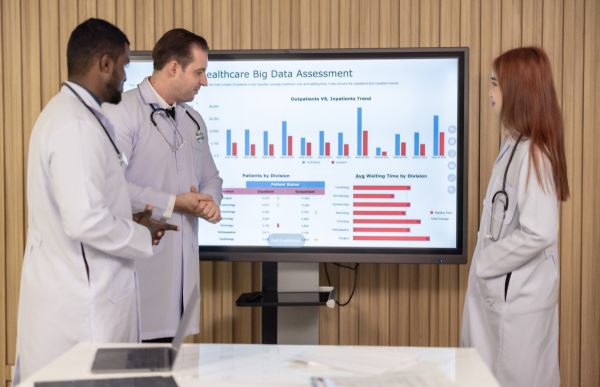In the intricate tapestry of healthcare, the management of the workforce stands as a critical thread that weaves together patient care, operational efficiency, and organizational success. Efficient healthcare workforce management isn’t just about filling shifts; it’s about aligning the right people with the right skills to deliver exceptional patient care. In this article, we delve into the strategies and practices that healthcare organizations can embrace to optimize their workforce management, ensuring that they are well-prepared to navigate the complexities of modern healthcare.
Assessing Workforce Needs in Healthcare Workforce Strategies
1. Analyzing Patient Demographics:
The first step in optimizing healthcare workforce management is understanding the patient population you serve. Different patient demographics require specific skill sets and care approaches. A pediatric ward, for instance, demands specialized pediatric nurses. By closely studying patient demographics, healthcare organizations can tailor their workforce accordingly.
2. Identifying Skill Gaps and Specializations:
With a thorough understanding of patient demographics, it becomes easier to identify skill gaps and required specializations. Healthcare professionals with expertise in certain areas can be strategically positioned to provide specialized care. Identifying and addressing skill gaps ensures that the workforce is equipped to meet patient needs effectively.
Implementing Predictive Analytics
1. Leveraging Data for Staffing Patterns:
Predictive analytics is a game-changer in healthcare workforce management. By analyzing historical data, organizations can predict patient admission patterns, enabling them to adjust staffing levels proactively. This prevents overstaffing during slow periods and understaffing during peak admissions.
2. Forecasting Patient Admission Spikes:
With the help of predictive analytics, healthcare organizations can anticipate patient admission spikes, such as flu seasons or holiday periods. By adjusting staffing schedules accordingly, they can ensure that patient care remains uninterrupted and of high quality.
Embracing Healthcare Workforce Software
1. Healthcare Workforce Management Software:
Advanced workforce management software brings automation and efficiency to scheduling, time tracking, and resource allocation. These solutions optimize shift assignments, reducing manual errors and freeing up administrative time for more strategic tasks.
2. Telehealth and Remote Work Solutions:
The digital era has ushered in the era of telehealth and remote work for healthcare professionals. This not only expands the reach of healthcare services but also offers flexibility for healthcare workers. Telehealth solutions can be integrated into workforce management, allowing for remote consultations and patient follow-ups.
Staff Scheduling Optimization
1. Balancing Workload and Employee Wellbeing:
Healthcare professionals often work demanding shifts, leading to fatigue and burnout. Effective scheduling involves balancing workload to prevent excessive stress on staff. By ensuring adequate rest periods and incorporating shift preferences, healthcare organizations prioritize employee wellbeing.
2. Creating Flexible and Adaptable Schedules:
Flexibility in scheduling is a hallmark of modern workforce management. Adaptable schedules accommodate the needs of both healthcare professionals and patients. Shift swaps, remote work options, and part-time schedules contribute to a balanced work-life integration.
Training and Continuous Education
1. Addressing Skills Shortages:
Rapid advancements in medical technology and treatment modalities lead to skill gaps among healthcare professionals. Organizations must offer targeted training programs to bridge these gaps. Whether it’s mastering a new medical technique or learning to operate advanced equipment, continuous education is key.
2. Promoting Lifelong Learning Culture:
The culture of lifelong learning benefits both healthcare professionals and organizations. By encouraging employees to seek out opportunities for growth and development, organizations foster a culture of innovation and ensure that the workforce remains current with the latest advancements.
Streamlining Communication Channels
1. Improving Interdepartmental Collaboration:
Effective communication among different departments is essential for smooth patient care. Streamlining communication channels reduces misunderstandings, improves patient handoffs, and enhances the overall patient experience.
2. Enhancing Patient-Provider Communication:
Clear communication between healthcare providers and patients is crucial for informed decision-making. Implementing tools such as secure messaging platforms and patient portals facilitates ongoing communication, empowering patients to actively participate in their care.
Data-Driven Decision Making
1. Utilizing Metrics for Decision Support:
Data-driven decision-making relies on key performance indicators (KPIs) and metrics to guide strategic choices. From patient satisfaction scores to staff turnover rates, these metrics provide valuable insights into areas that need improvement.
2. Aligning Staffing with Patient Demand:
Optimal staffing levels are closely linked to patient demand. By analyzing historical data and predicting future patient influxes, healthcare organizations can adjust staffing accordingly, ensuring that the right number of healthcare professionals is available to provide care.
Talent Acquisition and Retention Strategies
1. Attracting Skilled Healthcare Professionals:
In a competitive healthcare landscape, attracting top-tier talent is crucial. Organizations must showcase their commitment to professional growth, work-life balance, and career advancement to appeal to skilled healthcare professionals.
2. Fostering Positive Work Environment:
A positive work environment is a cornerstone of workforce optimization. A culture of respect, collaboration, and open communication not only boosts morale but also attracts and retains high-performing healthcare professionals.
Performance Management and Recognition
1. Setting Clear Performance Metrics:
Clearly defined performance metrics provide healthcare professionals with tangible goals to strive for. These metrics encompass clinical excellence, patient satisfaction, and adherence to best practices.
2. Acknowledging and Rewarding Excellence:
Recognizing and rewarding exceptional performance fosters a culture of excellence. Whether it’s through monetary incentives, awards, or public acknowledgment, recognizing healthcare professionals’ contributions motivates them to continue delivering high-quality care.
Addressing Burnout and Staff Wellbeing
1. Recognizing Signs of Burnout:
Burnout is a pressing concern in healthcare. Recognizing signs of burnout early allows organizations to provide support and resources to healthcare professionals, ensuring their mental and emotional wellbeing.
2. Implementing Wellbeing Programs:
Wellbeing programs encompass mental health support, stress management resources, and initiatives that promote work-life balance. These programs demonstrate a commitment to employee wellness and help prevent burnout.
Adapting to Regulatory Changes
1. Staying Compliant with Industry Standards:
Healthcare regulations are in a constant state of flux. Staying compliant with these standards is non-negotiable. Regular training and updates ensure that healthcare professionals are up-to-date with the latest protocols.
2. Navigating Evolving Healthcare Regulations:
Healthcare organizations must have mechanisms in place to quickly adapt to changes in regulations. This may involve revising policies, training staff on new procedures, and ensuring that all processes align with the current regulatory landscape.
Conclusion
The optimization of healthcare workforce management is a multidimensional endeavor that requires strategic thinking, innovation, and a commitment to patient-centered care. As healthcare organizations navigate the complexities of modern healthcare, embracing these strategies from data-driven decision-making to addressing burnout and fostering diversity will ensure that the healthcare workforce remains a strong pillar of patient care, operational excellence, and positive outcomes. By implementing healthcare workforce strategies and using advanced healthcare workforce management software, organizations can optimize healthcare workforce processes and rise to the challenges of the present and future, delivering care that is both impactful and transformative.



